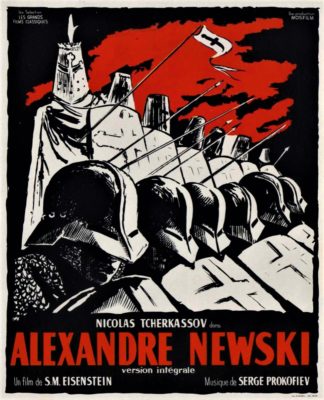In ’42, German forces advanced into Russia in the depths of winter. They were confident, thinking their foes weak and in retreat. They were about to be destroyed.
This was 1242, when a young Russian[1]ackchually pre-Russian or pre-pre-Russian prince lured an army of Teutonic knights and Estonian auxiliaries onto the frozen surface of Lake Peipus and slaughtered them on the ice. Alexander Nevsky’s victory is remembered in Russia as Ледовое Побоище, or Icy Massacre, and might be history’s only naval battle to not involve a single boat. It ended the Teutonic Order’s pretensions upon Novgorodian territory and turned Nevsky into a national hero, sainted in 1547.
Heroes never die. Even when they pass away, something of their essence remains in the national heartwood, inspiring others through the centuries. Seven centuries after Nevsky died, history began to loop back on itself. A prisoner in Germany wrote a book about the future. He was ambitious; mad. He wanted Europe in flames, and a German empire atop the bones of a Russian one. Eight years later that man was both free from prison and Chancellor of Germany. Armies were gathering, and Russia needed heroes once again.
It was inevitable that a film about Alexander Nevsky’s life would be made: a Russian patriot fighting German Catholics was a perfect propaganda coup. Also, Nevsky had died a very long time ago, and we don’t know much about him as a person. This allowed a director freedom to “interpret” him as whoever they wanted, as well as freeing him from troublesome contemporary politics (unlike the Russian generals who had fought Napoleon…on the side of the tsar).
Alexander Nevski was directed by Sergei Eisenstein, with many asterisks and scare-quotes around “directed”. Soviet culture regarded artists as civil servants; if you could write a poem or paint a picture you were expected to do so for the state (and under the state’s supervision). Eisenstein was regarded as suspect when he made the film: he’d spent years living in the west, only returning after what appears to be blackmail. His previous film Bezhin Meadow had failed and earned him a public reprimand. His friends were being arrested, and he soon suspected that the NKVD was shadowing him. Eisenstein probably saw Alexander Nevsky as his last chance, and resolved not to put a single foot wrong. It’s debatable to what extent it’s “his” movie.
It was filmed in 1938 and produced by Mosfilm, with the final cut receiving some additional tinkering by the Party. You could almost give Joseph Stalin an editing and production credit. The picture gained final approval from the State Committee for Cinematography and was released on December 1938, although it hit a snag when when the Molotov-Ribbentrop Pact turned Russia and Germany into momentary allies. Ultimately it was a success, rescuing Eisenstein’s reputation and gaining him a new following abroad. It’s a huge, huge film. Irrefutably part of the canon.
But is it good? Difficult question. As journalist Chet Flippo said after seeing a Queen concert, it “got the job done. I’m just not sure what the job is.”
As a movie it’s a disappointment, featuring rancid acting, a dull story, and sententious touches (medieval Teutons that wear swastikas) that turn its historical setting into chopped liver.
It’s a relic from a bygone age when film was theater’s little brother: get ready for ponderous cinematography, pounding melodrama, shouty brow-furrowing performances, and a total lack of subtlety. Your enjoyment of Alexander Nevski depends on whether you think shots like this are dramatic or silly.
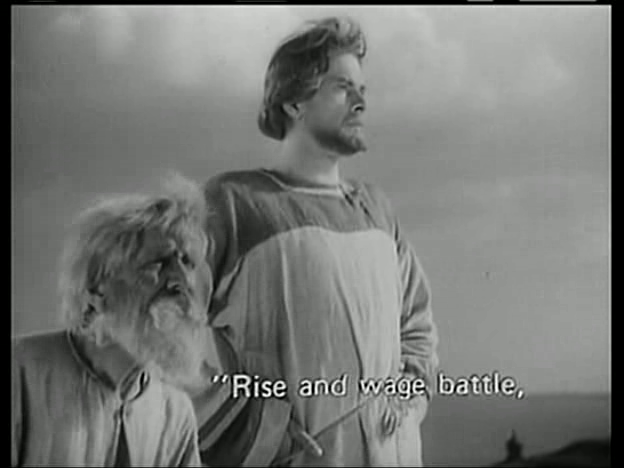
Nevsky is played by Nikolay Cherkasov, whose impression of a wooden board is second to none. His acting skills are suffocated by the role he’s playing: he’s Alexander Nevsky, Great Hero of the Motherland. He doesn’t have a love interest because his love is Russia, he can’t show weakness because Russia has no weaknesses, he can’t fart because that would be like Russia itself farting, etc…
Sergei Prokofiev’s score is acclaimed but I didn’t enjoy it: its shifts from movement to movement (with wildly different moods) sound weird and inorganic next to modern film scores. It’s probably great. I just can’t find a way into it. The subtitled dialog contains deathless Yoda-esque lines such as “They are strong! Hard will it be to fight them!” that hopefully flow better in the original Russian.
Eisenstein (as noted by Roger Ebert) sometimes made films that ascended directly to “great” without actually being good. Alexander Nevsky feels like that sort of movie: it has a spot on the film school curriculum but maybe not in the hearts of many students. It’s a 50 foot colossus with a clown shoes and a big red nose. Huge, important, towering above the landscape…but at the same time, it’s hard to take seriously.
In short, it’s a film of its time. In nearly every scene, shot, and frame, there’s something that jolts me out of the picture. The film at its best is a 1930s version of James Cameron’s Titanic, lavish and expensive, carrying the heft of history, with some innovative and somewhat impressive filmmaking techniques all built around a massive effects-driven set piece. At its worst, it’s patently absurd and laughable.
That’s one way of looking at Alexander Nevsky. The other is as a source of patriotic hope.
The darkness in the West hangs over all of this. You have to remember the circumstances of its production, who would have wanted to see it, and why. Many of Alexander Nevsky’s apparent flaws disappear when you watch it the way you’d listen to a national anthem as a patriot, or attend a church service as a believer.
The broad characterization and black-and-white morality are like anchors, points of stability in an unstable world. The Teutonic Knights are vile (there’s a horrible scene involving infants being thrown into a fire), but so were the real life Nazis. The film runs highlighter over Russian pride and German evil, relating everything back to the USSR’s contemporary circumstances. The historical garb is thinner than rice paper. I don’t think it was meant to be judged as a movie.
Even the film’s camp moments are interesting. At the start we see a Mongol chieftain offering Nevsky a command position in the Golden Horde (which is declined). He’s a silly fat man with a top-knot that looks like Mickey Mouse’s ears.
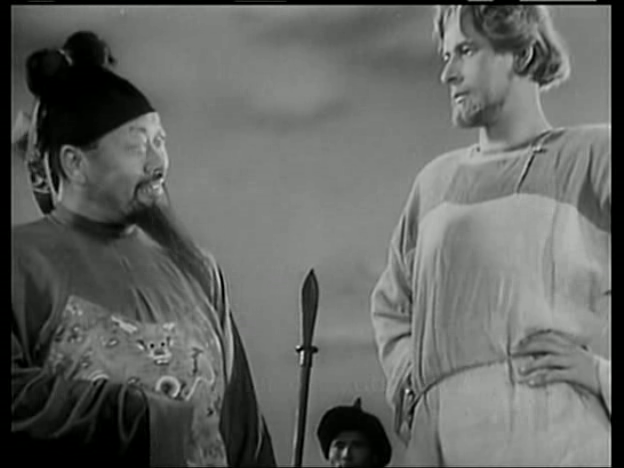
I am no expert, but I can’t find a photo of a traditional Mongolian (or Chinese) hairstyle that looks like that. It seems unique to the film. I half suspect we’re supposed to think of Mickey Mouse’s ears [2]Sergei Eisenstein visited America in 1930, and was apparently a fan of Walt Disney’s cartoons, so he certainly would have known about the character. – the black cap contrasting with his pale skin completes the image. Mickey Mouse (like Alexander Nevski) is inseparable from one particular country: the United States.
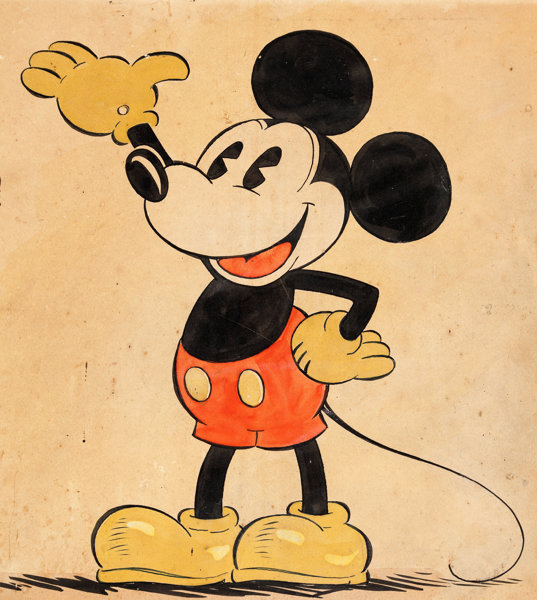
Does the Mongol Mouse represent capitalist America in the film? Just as Nevsky represents Russia? That would explain the ominous dialog where Nevski says that although the Mongols are a threat, the Germans are worse and must be fought first. “The Mongols can wait, methinks. We face more dangerous foes.” The difference, Nevsky goes on to explain, is that Mongols are greedy and can be placated with gifts (like capitalists), while the Germans are evil, destroying all that isn’t them (fascists). This anti-fascist angle, it must be said, now looks odd in light of how the Mongols are depicted as grubby savages, while Cherkasov is a tall, blond Aryan superman.
The rest of the film features more blatant pro-Soviet propaganda. Nevsky butts heads with with wealthy boyars (representing kulaks) and priests (representing…) who don’t understand the danger, want to appease the enemy, etc. Fortunately, Nevsky has the people on his side.
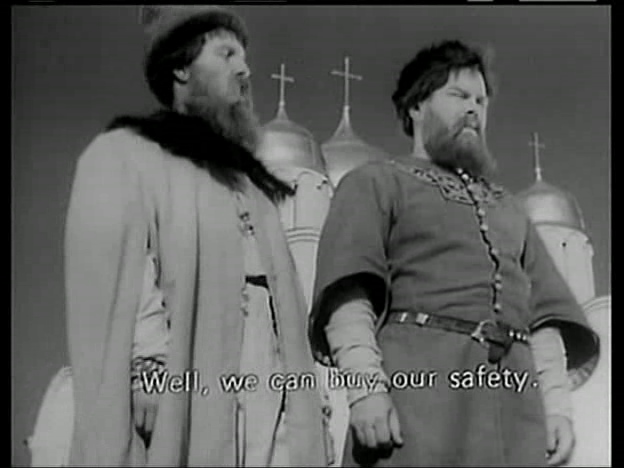
This isn’t even pseudo-history, it’s fan-fiction, like a teenage girl making Harry and Draco kiss. The real Alexander Nevsky was a rich aristocrat who took monastic vows. He wasn’t any kind of rabble-rousing working class hero (let alone an anti-capitalist or anti-clericalist). This is Russia’s 1930s political milieu projected seven hundred years into the past. But this is like noticing that Americans depict Jesus as white: it misses the point. Alexander Nevsky isn’t supposed to depict history except in a superficial way. It’s doing something more elemental, issuing marching orders to a nation.
What about the battle scene?
The final third of the movie is eaten up by an extremely long battle involving elaborate staging and hundreds of extras. The rest of the movie seems draped across this set-piece like a threadbare set of clothes (again, Titanic). When the horns blare and the massed columns of infantry advance onto the ice, you forget about everything that happened before. It’s its own self-contained universe.
The scene is groundbreaking – literally groundbreaking, it ends with an army falling through Lake Peipus – and ranks among the most thrilling moments yet seen in a movie. How did it take just forty years to go from Fred Ott’s Sneeze to this? Even today, the battle looks fairly good. Almost any time you see a motion picture featuring a cavalry charge – be it Peter Jackson’s Lord of the Rings, Mel Gibson’s Braveheart, or Sergey Bondarchuk’s Waterloo – it’s trying to look like Alexander Nevsky, consciously or otherwise.
Yes, you can sort of tell that the actors are being filmed under a bright sun on a hot day, but in black and white it’s not obvious. Films have something called “day for night” (a “night scene” that’s clearly not at night). Alexander Nevski went one further: hot for cold. Sand is used in place of snow. Huge sheets of broken glass are used in place of ice. The incredible thing is that it works.
It must have taken a staggering amount of money to film the battle. The costumes, props, and so forth look perfect, and there are hundreds of them. Within a few years, Russians would be facing the Germans with empty rifles, tanks without radios, etc. There’s a grim irony to the fact that (based on the opening weeks of Operation Barbarossa) the USSR was better at fighting a fake war than a real one.
It has some dated elements. Eisenstein wasn’t able to capture the violence and kinematics of an actual battle. Blows are half-hearted. People fall over dead for no reason. Horses are perfectly calm where they should be white eyed, terrified, and spraying foam.
This moment made me laugh. It was like a Keystone Kops gag.
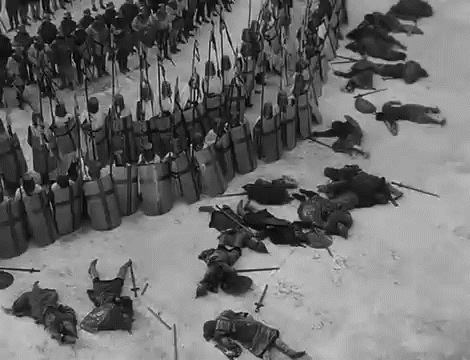
The sheer length of the battle wore me down. Just shot after endless shot of men swinging swords at enemies conspicuously out of frame. I’ll admit that after twenty minutes of this, I wasn’t overjoyed by the prospect of twenty more.
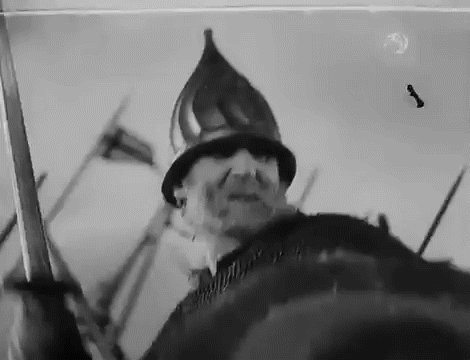
However, the battle ends on an striking visual: the beleaguered Germans collapse the ice with their weight and drown. This is apparently fiction – no contemporary accounts describe such an event – but it’s good, effective filmmaking, breaking the tedium of the battle and providing effective closure to the ice scene. It’s Chekov’s gun in the end. Put a gun on the set, and it has to get used. Put an army on a a frozen lake, and they have to fall through.
Many nations have legends of sleeping champions (Portugal’s King Sebastian, Britain’s King Arthur, Germany’s Frederick Barbarossa) who will return to fight for their homeland in its hour of need. But the atheistic USSR didn’t believe in such fairytales. They forced Nevsky back to life, through the magic of cinema. They probably thought they had to.
It’s a little hard to recommend the entire movie, although the battle is worth watching. Alexander Nevsky does not escape the time its in. You have to take it for what it is, a propaganda tool for a desperate nation facing desperate times. Seen with this in mind, it has a chilling power. Thunderclouds seem to hang above it. Walls of tanks clank in the background. Ahead lay a nightmare: a war so awful that historians disagree not just on how many Russians died, but how many million. The battle is inseparable from the mechanical savagery of Stalingrad and Kursk. The burning children reminds of the Holocaust.
Few films gain so much from their context, and few films have a context this awful. Alexander Nevsky is like a battle standard overlooking a battlefield. It’s just a crude image of a lion, fluttering in the wind. But underneath that lion are rivers of gore, shattered bones, smashed helmets and vambraces, cries of the wounded, and feasting crows.
References
No Comments »
Comments are moderated and may take up to 24 hours to appear.
No comments yet.

